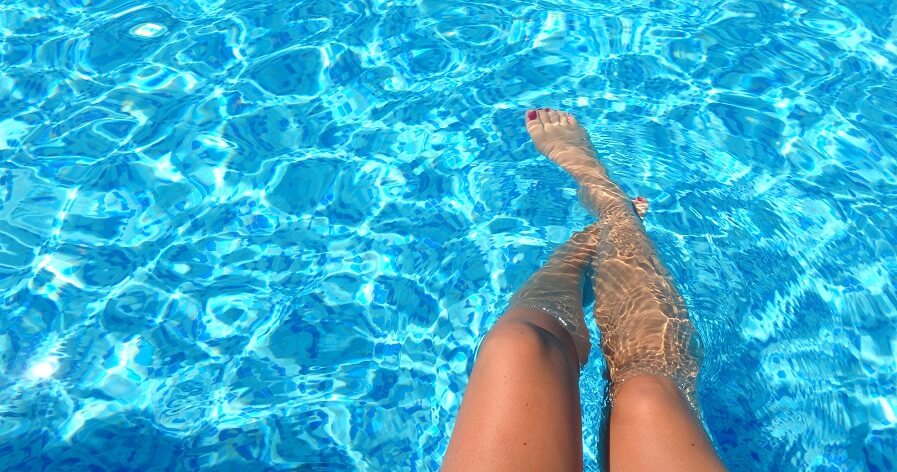
A Step-by-Step Guide to Keeping Inground Pools Safe & Protected
Did you know that the average in-ground pool can add around 28% value to your home when it’s safe and protected? And the best way to keep your pool safe is to balance the pool water. Keeping your pool water balanced is critical to ensure a safe and healthy swimming environment. But it’s not as simple as just making sure you have chlorine.
If any chemical is slightly off, it can throw the others off, making your pool a breeding ground for bacteria. Thankfully, balancing your pool water chemicals isn’t difficult. And it will eventually become routine.
To keep your pool safe, clean, and protected at all times, here’s a look at the importance of balanced pool water, along with the different types of chemicals to use and how to use them.
The Importance of Balanced Pool Water
Balanced pool water is clean, safe, healthy, and comfortable to swim in. And it will prevent damage to your pool’s structure and equipment.
Too much chlorine will cause skin and eye irritation, and potential illness, while too little will not be effective at killing bacteria, algae, and other contaminants.
If pH levels are too high, the water will become cloudy and create scale deposits on your pool walls and equipment. And if the pH levels are too low, the pool surfaces and equipment will become etched and corroded.
Simply put, unbalanced water can lead to plenty of unwanted issues with your pool. So do yourself and your pool a favour and keep your water balanced.
How Often to Test
Since pools are used less often during the cooler months, they may demand less chlorine. This can result in excess chlorine levels, which are detrimental to pool equipment and blankets. Backyard inground swimming pools should be tested with a test kit once a week. And if any of the chemicals are off-balance, you will need to test the water daily until the chemicals are balanced. Do the tests frequently if you have kids using the pool regularly.
7 Steps to Balance Pool Water
Testing and learning how to balance water chemicals can be quite challenging, especially if it’s your first time doing it. Stick to the following steps to balance your pool water. Before adding any chemicals to your pool water, make sure the pool pump is on so the chemicals will circulate in the pool.
1. Test and Adjust Total Alkalinity
Use test kits to test the total alkalinity in your pool water. A normal alkalinity reading needs to be between 80 and 120 parts per million.
A stabilizer will help raise the alkalinity if the cyanuric acid levels are low. Soda ash will do the same if the pH levels are low.
High alkalinity levels in the water may dilute the chlorine, reducing its effectiveness. You can lower them by adding muriatic acid to the water or aerating the pool. Muriatic acid neutralizes alkaline materials in a pool, while aeration helps break up alkaline materials.
2. Test and Adjust pH
The pH level of a substance refers to how acidic or basic the substance is, and falls within a range of 1.0 to 14.0, with 0.0 to 7.0 being acidic, and 7.0 to 14.0 being basic.
It’s crucial to keep the pH level balanced to protect your pool from damage.
The ideal pH level for pool water is 7.4 – 7.6.
To increase pH, add a pH increaser such as sodium carbonate (soda ash)—6 oz. of soda ash raises the pH of a 10,000-gallon pool by 0.2.
If your pH fluctuates, the Total Alkalinity might be too low. In that case, add baking soda to increase alkalinity and stabilize the pH.
To decrease pH, use a pH decreaser such as sodium bisulphate or muriatic acid.
3. Measure and Adjust Calcium Hardness
If calcium builds up in your pool water, you might start to notice a white line (scale) forming near your water line. Along with looking dirty, this scale buildup can damage your pool material and equipment.
The ideal Calcium Hardness level is 200 – 400 ppm.
If you need to increase your pool’s Calcium Hardness, add calcium chloride and follow the instructions on the label.
If you need to decrease the Calcium Hardness, partially drain your pool and refill it with fresh water. Also, use flocculants to collect excess calcium, and a pool vacuum to remove the excess calcium.
4. Add Sanitizer to Your Water
Sanitizer will keep your pool clean and free of bacteria, so the water remains safe and healthy to swim in. Chlorine is the most common type of sanitizer used in pools, and comes in the form of:
- Liquid chlorine
- Granular chlorine
- Chlorine tablets
- Salt chlorine generators
Shocking your pool is the fastest way to refresh and sanitize your pool water.
When testing the chlorine levels in your pool water, look at the:
- Free Chlorine—which is the amount of unused chlorine that is still available in the water
- Total Chlorine—which is the total amount of chlorine present in the water
Subtract the Total Chlorine from the Free Chlorine to find the pool’s used chlorine.
The ideal chlorine level in a pool is 3 ppm.
Other types of sanitizer include:
Bromine
Similar to chlorine but without the strong odour, bromine is also gentler on hair and skin, and is most often used in small pools and spas due to its higher price. And also, unlike chlorine, bromine is not stabilized so it will quickly burn away in sunlight.
The ideal bromine level in a pool is 3 – 5 ppm.
Biguanide
Biguanide must be used as part of a chemical sanitization trio, so it is more expensive than chlorine, and it cannot be used with traditional pool chemicals, algaecides, and shocks.
The ideal level of Biguanide is 30 – 50 ppm.
Minerals
Mineral sanitization systems are less common, but they are used to supplement chlorine and salt generators. Mineral systems release copper and silver ions into the pool water to help regulate pH.
These systems are relatively low maintenance, and only require the cartridge to be replaced every six months.
5. Check and Adjust Cyanuric Acid
Cyanuric Acid (CYA) prevents sunlight from burning away chlorine in pool water. While CYA is often found in pool shock, you may need to add more to ensure it is fully protecting your pool’s chlorine.
The ideal Cyanuric Acid level in pool water is 30 – 50 ppm.
Use test strips to check the cyanuric acid levels in your pool. Adding a pool stabilizer can help raise these levels if they are high. And to lower them, you should replace the pool water with fresh water.
6. Measure Your Water’s Total Dissolved Solids
Total dissolved solids (TDS) are organic and inorganic materials dissolved in a pool, such as chemicals, algaecides, shock, salts, dirt, and other contaminants.
Use a TDS meter to measure the amount of total dissolved solids in your pool water. You can also take a sample of the pool water to the lab for analysis. Since no chemical can lower TDS levels in pool water, the only solution is to dilute or replace part of the water with fresh, unsaturated water.
If your pool’s TDS level is below 2,000, then you don’t need to adjust the water.
But if your pool’s TDS level rises above 2,000, then you’ll need to drain small amounts of the pool water and refill with fresh water, testing until the TDS levels drop below 2,000.
7. Shock Your Swimming Pool
Shocking your pool helps refresh the water, so it is sanitized, clean, and safe to use.
To shock your pool:
- Fill a 5-gallon bucket with warm water
- Slowly mix in a one-pound bag of pool shock into the bucket of water
- Stir with a stick until the shock dissolves
- While walking around the pool, gradually pour the bucket of shock water into the pool, pouring most of it into the deep end.
Test the pool water at least six hours after shocking the pool and make any necessary adjustments as outlined in the steps above.
What About Pool Temperature?
The temperature of pool water will influence the effectiveness of pool chemicals. At higher temperatures, the water and chemicals are more active, so you may need to use fewer chemicals to balance the water. And at lower temperatures, you may need to add more chemicals to balance the water.
But do keep in mind that bacteria and algae thrive in warm water, so your chlorine might be used up faster in warm temperatures.
You can use to a Saturation Index calculator to determine the ideal levels for your pool chemicals based on the water temperature.
Balancing a pool is fairly easy, especially with a list of steps and getting into the habit of doing it regularly. And well-balanced pool water ensures your pool is safe and protected, so you can spend less time worrying about the water and more time enjoying your pool instead.
How to Balance Pool Water: The Takeaway
Balancing new pool water is one of the important duties you have to honour as a pool owner. If you neglect this task, the water may turn green or cloudy and irritate your eyes or skin.
Another sure-fire way to manage your pool chemistry is to take your water in for testing. A pool testing service takes all the guesswork to balance your pool. Bring in a sample of your pool water for testing and your local pool store will not only test the water but tell you exactly what chemicals you need in the right amounts to help you keep your pool completely balanced.
And if you’re looking for a custom pool builder, Edgewater Pools has your back. We strive to deliver stunning results through our professional services. Book your consultation today to learn more about how to balance pool water.

Bert Minor has been a part of the landscaping business for nearly twenty years and has gained an excellent reputation as an innovative and creative designer. In fact, several of his designs and projects have been featured in industry supplier magazines. An active and contributing member of the industry, Bert sat on various boards including the Ottawa Chapter of Landscape Ontario and the Landscape Ontario Provincial Construction Committee. Bert also contributed technical articles published in the Canadian National Landscape Association magazine. With a relentless pursuit of knowledge, Bert has attained several industry certificates in landscape design, landscape construction and with the PHTCC—Pool and Hot Tub Council Canada. Prior to joining the landscaping industry, Bert spent several years in management in the services sector primarily in a customer advocate role. His honesty and integrity and his ability to build and develop strong relationships with clients reflects that.
